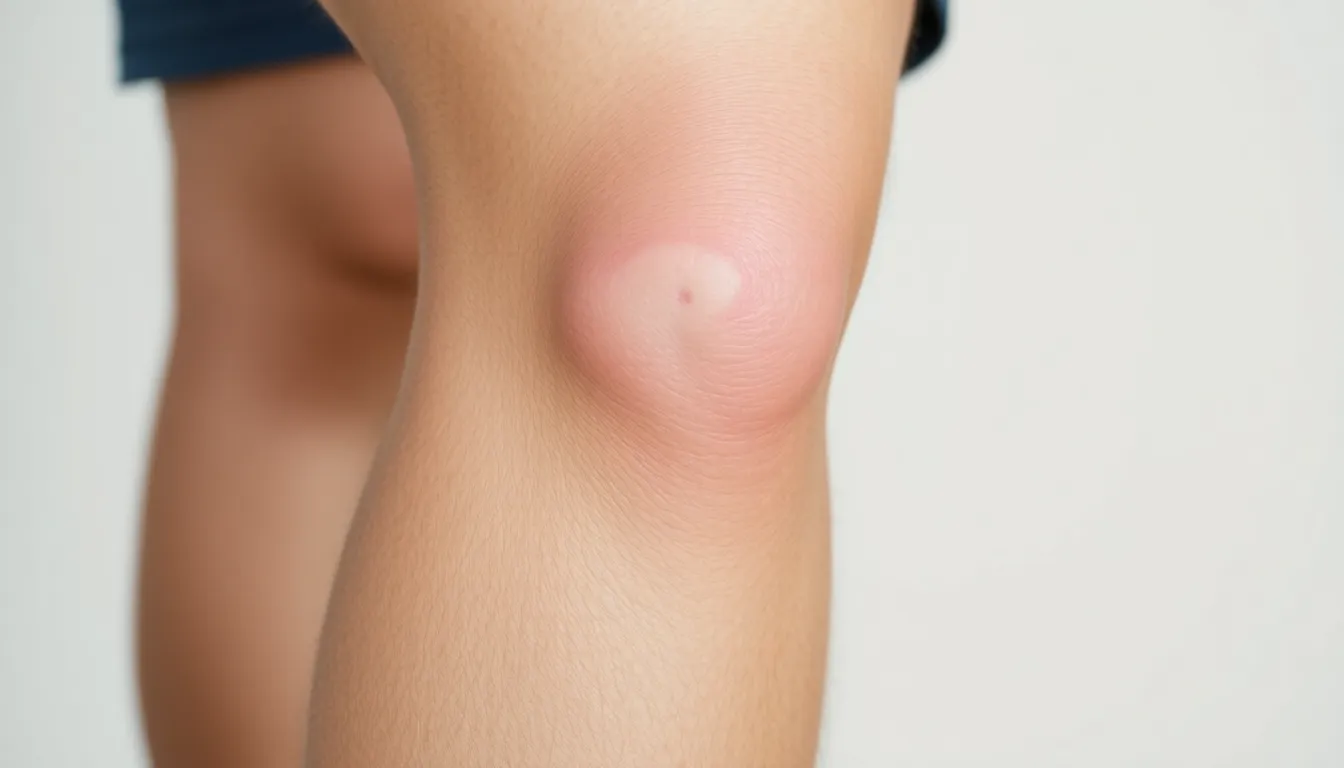Table of Contents
ToggleA pea-sized lump on the knee cap might not scream “emergency,” but it sure can stir up a whirlwind of curiosity and concern. Is it a secret stash of snacks? A tiny alien trying to make contact? While the imagination can run wild, the reality is often much more mundane. These little bumps can be surprisingly common and often harmless, but they can also signal something that deserves a closer look.
Overview Of Pea Sized Lump On Knee Cap
A pea-sized lump on the knee cap often causes concern but is typically benign. Common conditions include cysts, lipomas, or bursitis. Each of these may lead to a lump that feels firm and movable.
Cysts often form due to fluid buildup, presenting as smooth, soft lumps. Lipomas consist of fatty tissue and usually appear painless. Bursitis arises from inflammation, often resulting in tenderness around the knee.
Location of the lump plays a role in its evaluation. If situated directly on the knee cap, it’s likely related to the skin or underlying tissues. In contrast, lumps away from the knee may indicate issues like swollen lymph nodes or popliteal cysts.
Size of the lump can also vary, but if it remains consistent, it might not be a cause for alarm. Any increase in size, however, warrants assessment. Accompanying symptoms, such as pain or limited mobility, should influence the urgency of seeking medical advice.
Diagnosis usually involves a physical examination and, if necessary, imaging studies. Medical professionals may recommend ultrasound or MRI scans to gain further insight into the lump’s characteristics.
While many pea-sized lumps remain harmless, tracking any changes is essential. Each individual response to a lump can differ, making personal observation important. Consultation with a healthcare provider ensures accurate diagnosis and appropriate management, alleviating concerns for those affected.
Possible Causes

A pea-sized lump on the knee cap may arise from various conditions. Identifying the underlying cause is essential for appropriate management.
Benign Conditions
Benign conditions often lead to lumps on the knee. Commonly, sebaceous cysts develop from blocked glands and appear smooth. Lipomas, which are non-cancerous fatty tissue growths, typically remain painless and soft. Baker’s cysts result from knee joint issues and often present at the back of the knee. All these conditions usually pose no serious health risks, but monitoring is advised.
Injuries
Injuries can result in lumps due to localized swelling. Contusions, or bruises, occur when blood vessels burst after trauma, leading to a bump. Fractures may also cause swelling in the knee area, creating noticeable lumps. Tendon injuries, especially around the kneecap, can generate lumps caused by inflammation or swelling. While many injuries heal naturally, persistent pain warrants medical evaluation.
Infections
Infections can form lumps around the knee area. Bacterial infections, such as cellulitis, cause inflammation and resultant swelling. The presence of a bump can indicate an abscess filled with pus, often requiring treatment for drainage. Septic arthritis involves infection in the joint, leading to pain and swelling. Early medical intervention is crucial when infections are suspected to avoid complications.
Symptoms To Watch For
Individuals with a pea-sized lump on the knee cap may notice various symptoms. Size and location often matter when assessing the lump. Swelling around the lump can indicate inflammation or injury. Redness and warmth may accompany the lump, signaling an infection or inflammation.
Pain is another crucial symptom. Sharp or persistent pain might suggest a more serious condition. Discomfort during movement could point towards a tendon issue or bursitis. It’s essential to note any change in range of motion as well, especially if it becomes restricted.
When observing the lump, its texture can reveal valuable information. A smooth, soft lump may suggest a benign cyst, while a firm lump could indicate a lipoma or other growth. Any increase in size over time usually warrants closer examination.
Monitoring for systemic symptoms is also important. Fever could indicate an underlying infection, thus requiring immediate medical assessment. If the individual experiences joint stiffness accompanying the lump, this could suggest arthritis or another joint condition.
Identifying these symptoms early can assist healthcare providers in making an accurate diagnosis. Keeping track of how symptoms evolve over time supports a comprehensive evaluation. Seeking medical advice remains essential, especially if there are concerns or persistent symptoms.
Diagnosis Process
Diagnosing a pea-sized lump on the knee cap involves a thorough evaluation to determine its nature and cause. Healthcare professionals typically start with a detailed assessment of symptoms.
Physical Examination
A physical examination plays a crucial role in the diagnosis process. The healthcare provider visually inspects the knee area for lumps, swelling, or skin changes. They palpate the lump to assess its size, shape, and texture. Asking about pain levels may reveal additional information about its characteristics. Mobility tests help determine if the lump affects knee movement. Trying to understand the duration of the lump’s presence and any accompanying symptoms aids in the evaluation. Observing for signs of infection, such as redness or increased warmth, can indicate the need for further attention.
Imaging Tests
Imaging tests provide a clearer picture of the lump’s structure and surrounding tissues. Often, ultrasounds are the first choice, as they offer a non-invasive view of soft tissues. Healthcare providers may also recommend MRIs for detailed images of joints and adjacent structures. These imaging studies help identify possible cysts or other abnormalities within the knee. Evaluating the images allows for distinguishing between benign lumps and those requiring treatment. When necessary, these diagnostic tools enhance understanding and guide appropriate interventions.
Treatment Options
Addressing a pea-sized lump on the knee cap involves various approaches, depending on the underlying cause and symptoms.
Home Remedies
Resting the affected knee can help reduce strain and inflammation. Applying ice for 15 to 20 minutes several times a day may lessen swelling and discomfort. Over-the-counter pain relievers, such as ibuprofen or acetaminophen, can also alleviate pain and inflammation. Elevating the knee while sitting or lying down aids in reducing swelling. Gentle stretching and strengthening exercises can improve mobility, though it’s essential to avoid movements that cause pain. Keeping the area clean and monitoring any changes in the lump is necessary for ongoing care.
Medical Treatments
Consulting a healthcare professional remains vital for determining the appropriate course of action. In cases of inflammation or infection, prescription medications, such as corticosteroids or antibiotics, may be necessary. Aspiration could be performed to drain fluid from cysts if they become uncomfortable. Surgical procedures may be required to remove problematic lumps or address underlying conditions. Physical therapy can assist with rehabilitation and healing, particularly for injuries. Regular follow-ups with a healthcare provider ensure proper monitoring and management of the lump.
When To See A Doctor
Consult a healthcare provider if a pea-sized lump on the knee cap appears suddenly. Observe any changes in size, shape, or color over time. Seek medical attention if the lump becomes painful or tender, as this might indicate an underlying issue.
Consider the presence of systemic symptoms such as fever or joint stiffness. These can signify a more serious condition that requires prompt evaluation. Remember that persistent swelling, redness, or warmth around the lump often points to infection or inflammation and should not be ignored.
A visit to a healthcare professional becomes necessary if the lump interferes with movement or causes significant discomfort. Medical evaluation usually starts with a physical examination, during which the doctor assesses the lump’s characteristics and any related symptoms. Expect the possibility of imaging tests like ultrasounds or MRIs to clarify the diagnosis.
Waiting too long before seeking medical guidance can lead to complications. If the lump’s texture changes or you notice new lumps developing, this warrants an immediate check-up. Health professionals provide adequate advice based on the lump’s nature and associated factors.
Even if the lump seems benign, staying proactive about monitoring and evaluating it ensures good health. Engaging with a healthcare provider helps in understanding the cause and deciding on the best course of action. Prioritizing these steps facilitates timely diagnosis and effective management when necessary.
A pea-sized lump on the knee cap can be a source of concern but often isn’t a cause for alarm. While many lumps are benign and harmless, it’s essential to stay vigilant and monitor any changes. Understanding the characteristics of the lump and accompanying symptoms can help in assessing its significance.
Consulting a healthcare provider is vital if any unusual signs develop or if pain and discomfort arise. Early evaluation can lead to timely diagnosis and appropriate management. By keeping a close eye on the lump and seeking professional advice when necessary, individuals can ensure their knee health remains a priority.







